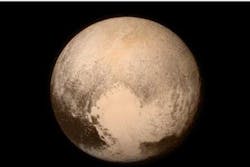Close-up Pluto images arrive; another success for e2v image sensors
Images of Pluto, which show a beige-colored planet with a pale heart shape and dark shadows along one side, were taken during an hour-long fly-by Pluto on NASA's New Horizons mission using image sensors from e2v (Chelmsford, England). The spacecraft set off from earth on January 19, 2006 and traveled for nine and a half years to reach the planet.
RELATED ARTICLE: e2v image sensors to capture first close-up images of Pluto and its moon
Matt Perkins, president of Space Imaging at e2v, said, "Very little is known about Pluto. It is classed as an icy dwarf, with a significant part of its mass believed to be made up of ice. It is so far away that even images from Hubble, which also uses e2v image sensors, are very blurred.
The two sensors are LORRI (a long range reconnaissance imager), which is the same as the one used on Rosetta (currently studying comet 67P) and provides black and white pictures, and Ralph, which will scan the surface of the planet to build up a color image and also scan for methane.
But the planet is so far away, that even travelling at the speed of light, the images will take four and a half hours to reach scientists on Earth.
Pluto is the final planet in the solar system to have been visited by a probe launched from Earth, and the images bring scientists a step closer to understanding whether or not there could be life in other solar systems.
Paul Jerram, e2v's chief engineer or images sensors, told the Chronicle, "Until a few weeks ago, the pictures taken were of a fuzzy blob, taken from the space station Hubble, the space telescope that orbits earth. They were also taken using our image sensors, but it wasn't close enough to take detailed images. So until now, no one knew what Pluto looked like.”
Having passed Pluto during the hour-long fly-by, the New Horizons spacecraft will now continue through the Kuiper Belt, taking pictures of anything it may encounter in the unexplored region of the solar system. But it could take years for scientists to study all the data found, as it will take five years for the probe to get through the Kuiper Belt, and all the data will take a year to get back to Earth.
SOURCE: Essex Chronicle; http://www.essexchronicle.co.uk/NASA-s-New-Horizons-mission-Pluto-uses/story-26905187-detail/story.html
About the Author

Gail Overton
Senior Editor (2004-2020)
Gail has more than 30 years of engineering, marketing, product management, and editorial experience in the photonics and optical communications industry. Before joining the staff at Laser Focus World in 2004, she held many product management and product marketing roles in the fiber-optics industry, most notably at Hughes (El Segundo, CA), GTE Labs (Waltham, MA), Corning (Corning, NY), Photon Kinetics (Beaverton, OR), and Newport Corporation (Irvine, CA). During her marketing career, Gail published articles in WDM Solutions and Sensors magazine and traveled internationally to conduct product and sales training. Gail received her BS degree in physics, with an emphasis in optics, from San Diego State University in San Diego, CA in May 1986.
